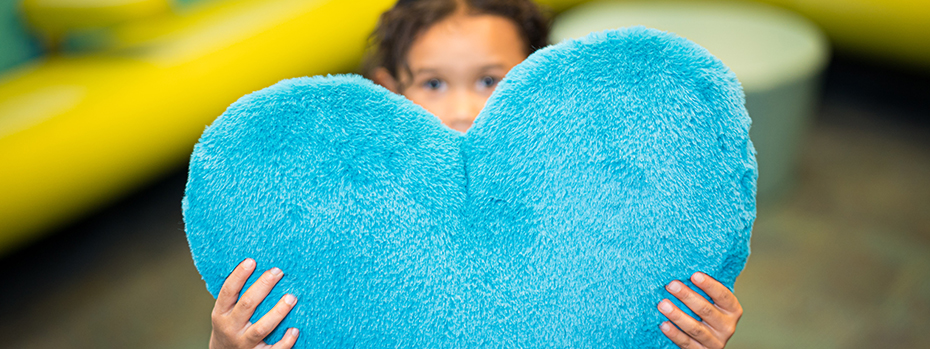Pediatric Anxiety Disorders

Our Anxiety Clinic offers help for children and teens with:
- Complex medical, developmental or psychological conditions.
- Anxiety that has not responded to treatment.
We offer:
- A team led by a pediatric psychologist with extensive experience.
- A full evaluation to get to know your child or teen and plan treatment.
- A therapy-first approach.
We help families heal emotionally and learn skills to treat and manage anxiety symptoms. We teach skills that are evidence-based. That means they’re based on:
- The best available research.
- Expertise in health care.
- Experience working with patients.
Understanding anxiety disorders
Children have anxiety or fear now and then. It’s a normal reaction to stress. For those with a disorder, anxiety gets in the way of daily life, such as school, friendships and family time.
Who gets anxiety disorders?
Anxiety disorders affect about 7% of children ages 3-17, according to the Centers for Disease Control and Prevention. More than 1 in 3 have behavior problems, and about 1 in 3 have depression. Teens have anxiety disorders more often than younger children.
What causes anxiety disorders?
Medical experts don’t fully understand what causes anxiety disorders. It is likely that the risk of an anxiety disorder is linked to a combination of genetics and a child’s environment.
Risk factors generally include:
- Personality traits such as shyness.
- Trauma or abuse for a survivor or witness.
- Personal or family history of anxiety or other mental health disorders.
- Health conditions such as arrhythmia (irregular heartbeat) and thyroid problems.
- Medications or substances such as caffeine.
Signs and symptoms
Signs and symptoms of each disorder vary. They share some features:
Psychological symptoms:
- Being nervous, restless or irritable
- Feelings of looming danger or loss of control
- Sleep problems
- Trouble focusing or controlling worry
- Avoiding things or situations that trigger fears or worries
Physical symptoms:
- Increased or pounding heartbeat
- Shortness of breath or rapid breathing
- Upset stomach, nausea or bowel problems
- Too much sweating
- Shaking or trembling
- Fatigue
Anxiety disorders we treat
- Anxiety disorder caused by a medical condition: Intense anxiety or panic because of a physical health problem.
- Generalized anxiety disorder (GAD): Anxiety about routine issues on most days for six months or more.
- Panic attacks: Sudden surges of intense fear or discomfort.
- Panic disorder: Repeated panic attacks with four or more symptoms, such as fear of dying, shortness of breath or dizziness.
- Selective mutism: Not speaking in certain situations, such as at school.
- Separation anxiety disorder: High anxiety about being apart from parents or others.
- Social anxiety disorder: Intense anxiety about social situations.
- Phobias: Intense fear of objects or situations, such as blood, needles, heights or flying.
Anxiety-related conditions we treat
- Avoidant/restrictive food intake disorder: Limiting amount and/or type of food over fears of choking, vomiting or contamination.
- Emetophobia: Fear of vomiting.
- Misophonia: Psychological sensitivity to sounds such as chewing or breathing.
- Obsessive-compulsive disorder (OCD): Unwanted feelings (obsessions) and thought patterns that lead to repeated behaviors (compulsions).
- Post-traumatic stress disorder (PTSD): Intense anxiety, uncontrollable thoughts, flashbacks and nightmares after a traumatic event.
- Restricted eating: When related to anxiety or obsessive-compulsive thoughts and behaviors.
- Vocal cord dysfunction: Closure of the vocal cords when a person inhales, hindering breathing; can be from anxiety.
Evaluation
Families typically come to our Anxiety Clinic when a child has severe worry, fear or distress that gets in the way of activities and a fulfilling life. Most patients are ages 5-18.
Ask your child’s doctor for a referral. We will review your child’s medical records before you see us.
What to expect
Our evaluation includes:
- One or more questionnaires for you and possibly your child, depending on age.
- An interview. Parents are included, though we may talk with teens alone for part of the time.
- A diagnosis.
- Treatment recommendations.
Follow-up visits
We often meet with families every other week for 45 minutes, for six to 18 visits. Spacing and number of visits can vary. Some families may be able to schedule virtual visits on our private system.
Treatment for anxiety disorders
Psychological services
At each visit, we:
- Provide strategies and tools.
- Help you develop skills.
- Ask you to try specific strategies before your next visit.
We provide a type of cognitive behavioral therapy called exposure and response prevention (ERP). This type of therapy has the strongest set of research showing it to be effective. ERP focuses on gradual exposure to situations that cause anxiety.
We help your child and family:
- Build coping skills.
- Learn to manage and change unhelpful thinking patterns.
- Improve self-confidence.
- Find better ways to interact and manage problems.
- Manage fears more effectively.
Medications
If we think medication might help, we will work with your child’s doctor to meet your family’s needs.
Research and innovations
Our pediatric psychologist knows the latest research so we can provide up-to-date therapies. The team’s research interests include:
- Post-traumatic stress disorder (PTSD) and trauma in children and teens.
- Obsessive-compulsive disorder (OCD) in children and teens.
Learn more
- Your adolescent — anxiety and avoidant disorders, American Academy of Child and Adolescent Psychiatry
- Anxiety and depression in children, CDC
- Any Anxiety Disorder, National Institute of Mental Health
Resources
- Anxiety resources, National Federation of Families
- Anxiety & Depression Association of America
- The National Child Traumatic Stress Network
Director

Danny C. Duke, Ph.D., is the director of the Anxiety Clinic. Our clinic is part of OHSU’s Child Development and Rehabilitation Center (CDRC).
For patients
- 503-346-0640
- 877-346-0640 toll-free
Location
OHSU Doernbecher Children’s Hospital, seventh floor
700 S.W. Campus Drive
Portland, OR 97239
Free parking for patients and visitors
Refer a patient
- Fax our referral form to 503-346-6854
- Get provider-to-provider advice: 503-346-0644